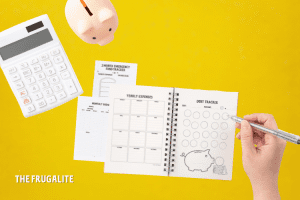(Psst: The FTC wants me to remind you that this website contains affiliate links. That means if you make a purchase from a link you click on, I might receive a small commission. This does not increase the price you’ll pay for that item nor does it decrease the awesomeness of the item. ~ Daisy)
By the author of The Ultimate Guide to Frugal Living and The Flat Broke Cookbook
Want to get your finances on track in 2023? That might sound like a tall order, with the economic difficulties and inflation we’re all facing. But all is not lost. In fact, there are some simple things you can do to cut your costs.
By choosing easy steps, you won’t get overwhelmed, and you’ll be far more likely to stick to your resolutions than if you try to completely up-end the way you’ve been doing things for years.
And don’t think that easy stuff doesn’t equate to big savings. Depending on your spending now, you could potentially shave off $300-500 each month with these simple swaps.
1.) Shop around for better deals on insurance.
By shopping around and comparing prices, you can potentially save hundreds of dollars on insurance premiums. Research and compare prices from different companies or providers and negotiate for better rates. Often if you tell your company that you are planning to leave, they’ll match the lower price you found. Be sure to compare apples to apples – write down the details of your coverage such as the amount covered, roadside assistance, and rental cars, etc. I do this twice a year to make sure I’m paying the lowest possible price.
People who shop around for insurance save on average $356 per year, or $29 per month.
2.) Make one upgrade each month to reduce your utility consumption.
This might mean installing a programmable thermostat, replacing bulbs with more efficient ones, or putting in a low-flow faucet. Choose a project that you can do yourself and calculate how long it will take for you to see the savings. Check out this article for more ideas to save on your electric bills. Decide ahead of time what day of the month you’ll do this. (Or, for example, the first weekend of the month as opposed to a specific date.)
The upgrades you do determine your savings, but you can expect to slash bills by at least $30 per month by the end of the year.
3.) Save money on gas by grouping your to-do list together on Errand Day.
Don’t run out for “just one thing.” Set aside one day per week in which you handle all your errands such as shopping, bill paying, and picking up packages. Get more ideas for saving money on gas in this article.
Doing everything in one trip can save you a lot of money on fuel. The amount depends on how far away things are from you and the efficiency of your vehicle. All in all, expect to save a tank of gas each month, which can range from $40-90, depending on your vehicle.
4.) Save money on food by meal planning and food prep.
Plan your meals ahead of time and prep as much of your food as possible. I do this on grocery shopping day when putting things away. I often cook for the entire week on Sundays and package up my food so I only have to heat and eat. It sounds like a lot of work at first, but you’ll thank yourself throughout the week when dinner is on the table faster than you can dial 1-800-4PIZZA.
I promise once you start this, you won’t want to stop because your life will be so much easier. Here are my tips on meal prep. Bonus: Not only can food prep keep you on budget, but it can also help you meet your nutritional goals.
You’ll save money in several ways here: first, you’ll stick to your budget because you know what you need. Second, you’ll avoid the temptation to hit drive-through because you have something ready at home. And finally, you’ll waste less food because everything you’ve purchased that week has a purpose on the menu. Expect to save $20 weekly or $80 per month by implementing meal planning and food prep into your life.
5.) Cut the cable.
If you can get rid of cable and use a streaming service instead, you’ll save significant money. Replace your monthly cable or satellite bill with one streaming service such as Amazon Prime or Netflix. Caveat: you do need high-speed internet for this. Or, you may want to do without television altogether. Check out these ideas.
Depending on how much you spend right now on cable, this could save more than one hundred dollars monthly.
6.) Break up with the gym.
Do you have a pricey gym membership? Do you actually get your money’s worth from it? A lot folks sign up for the gym this time of year, but I suggest that you do the opposite – cancel that membership unless you are truly using it regularly. Use YouTube for workouts, go for a walk, or create a thrifty home gym. Simply having an active lifestyle can make a tremendous difference in your fitness levels without the monthly payment. Add extra steps to your day, carry your groceries instead of pushing a cart, and go outside and play with the children instead of sitting inside in front of the television.
By cutting out your gym membership, you’ll save $30-80 each month.
7.) Drink tap water.
You can save a fortune by making your beverage of choice the free stuff that flows from the taps. This is particularly true if your beverage of choice is soda pop, sports drinks, or fancy sparkling stuff. I filter my tap water. Depending on the level of ick in your tap water you can use anything from a Brita to a gravity fed water filter like a Berkey.
If a case of soda pop costs $8, and your family goes through one weekly, that’s $48 in savings monthly.
So how much did we save with these changes?
If you make these seven non-life-altering changes, you could potentially save anywhere from $307 to $500 every single month. Isn’t that extra money in your pocket worth a few simple changes?
Are you looking for even more ways to save money? Check out our yearbook of money-saving awesomeness, with more than a thousand pages of tips for living large on a tiny budget.
Do you have any other easy changes that really add up? Let us know about them in the comments. Let’s share some ideas and save some money!
About Daisy
Daisy Luther is a coffee-swigging, adventure-seeking, globe-trotting blogger. She is the founder and publisher of three websites. 1) The Organic Prepper, which is about current events, preparedness, self-reliance, and the pursuit of liberty; 2) The Frugalite, a website with thrifty tips and solutions to help people get a handle on their personal finances without feeling deprived; and 3) PreppersDailyNews.com, an aggregate site where you can find links to all the most important news for those who wish to be prepared. Her work is widely republished across alternative media and she has appeared in many interviews.
Daisy is the best-selling author of 5 traditionally published books, 12 self-published books, and runs a small digital publishing company with PDF guides, printables, and courses at SelfRelianceand Survival.com You can find her on Facebook, Pinterest, Gab, MeWe, Parler, Instagram, and Twitter.












7 thoughts on “Save $300 a Month with 7 Super-Easy Changes”
Good advice whether one needs to cut expenses or not.
We’ve been on the light bulb “kick” these past few days. Besides saving a bit of money, better light which is also a safety plus.
A. Grocery shop only once or twice a month.
B. Make your own Spaghetti Sauce, Salsa, and Taco Sauce.
C. Eat cheap foods–Popcorn, Pasta, Beans, Rice, Salads, etc..
D. If you normally buy Bottled Water, invest in a Berkey Water Filter System and make your own purified Water from Tap Water.
E. Cut back on eating out.
F. Wear warm clothes and turn down the Thermostat in Winter.
G. Invest in a Deep Freezer so you can stock up on high priced meat when it’s put on sale. Sometimes you can get a free Deep Freezer on the Craigslist “free” catagory.
I like your ideas, very helpful. But I won’t drink tap water. If you cultured the water in my city, you’d be shocked at what would grow in a petri dish. (advice from my microbiology professor) Plus, I don’t want the fluoride. Other than that, these look like great pieces of advice. Thanks!
Oh – I forgot to add the suggestion to filter it 🙂 Thank you for your comment! I don’t care for water that isn’t filtered either.
re: clean water
With the constantly changing tap water contaminants, dishonest government officials (think Flint, Michigan), and conflicting details/lawsuits against water filter companies, I realized that I only needed super clean water for a few purposes. I don’t need to it wash the car, water the lawn, hose down the dog, etc. I can even use contaminated water (once it has boiled off any VOCs (volatile organic compounds) to steam cook many kinds of foods. So two decades back I installed a kitchen countertop water distiller that has nicely taken care of the minimal super clean water needs … with confidence that I don’t need to worry about changing contaminants, regular water quality testing, government official dishonesty, inadequate regulatory rules, etc, etc.
In case of a long term power outage, I know how to build a passive solar distiller (that looks about like a pool table with a slanted glass top). Sharon Buydens has a good DIY how-to book for that on Amazon. Many entire families along the US border with Mexico use that design for their drinking water.
re: cell phone choices:
Lots of people are reverting back to plain old less costly flip phones. Some don’t like the smart phone costs, some don’t want to risk the hacker intrusions, and some realize that Warren Buffett who can certainly afford any smart phone …refuses to have one!
re: freezers
I realize that if a long term power outage is sprung on us, the contents of most people’s freezer will get trashed. Most Amish don’t use freezers because they use other food preservations methods that don’t require electricity. There are some exceptions where they use propane-powered cooling. My thought is to minimize my needs for such cooling needs with some changes in food types and cooking styles.
This very recent article discusses some of the ways the Amish get along without electric power:
https://www.naturalnews.com/2022-12-24-learn-to-live-without-electricity-from-amish.html#
re: exercise
I live close enough to most (not all) businesses I regularly visit that I can walk back and forth there. My perspective is to look for opportunities to walk instead of drive because it’s better exercise for me and it’s cheaper regarding my wheels, gas and maintenance.
re: outside water faucet freezing risks
While I’ve long used incandescent light bulbs in mechanic’s trouble lights close to my outside water faucets in case of freezing weather forecasts, I’ve worried about a power outage in the middle of such a disaster that could generate a really nasty plumbing repair bill. So I recently took delivery on a couple Freeze Miser items (about $30/ea from Amazon or from freezemiser.com that mechanically open up a drip system whenever temperatures start dropping close to freezing. Their turn on and turn off system is completely independent of any electric power.
re: medical care in a system collapse
I’m seeing this book being advertised recently that looks very useful in case a system collapse prevents one from access to doctors or medications:
Home Doctor practical book, by Dr Maybell Nieves — based on what worked in Venezuela after their collapse
https://homedoctorbook.com/book/
–Lewis
The homedoctor book may be of real value for those who live in health care deserts. Deserts that for various reasons are increasing by the day.
We have frost free outdoor faucets – one of the many plumbing/heating/cooling/electrical upgrades we did when we bought our current house. None of these upgrades are of the ‘look at this” candidates but those plus windows/doors/insulation pay for themselves over a short period of time.